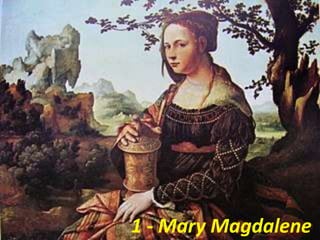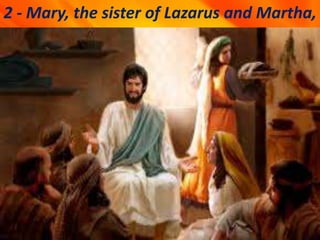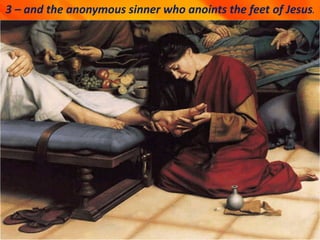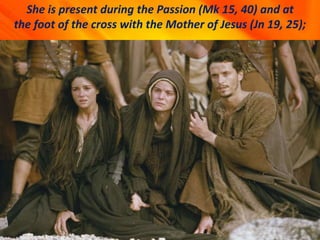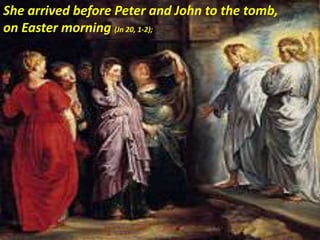|
|
General: MARY MAGDALENE ENDED HER DAYS IN EPHESUS WITH SAINT JOHN AND THE HOLY VIRGIN?
Elegir otro panel de mensajes |
|
|
It is said that if you want to see the relics of Mary Magdalene, you must travel to the church of Vézelay in Provence, France. These objects have been extremely controversial, as they are surrounded by legends and contradictory stories.
Some say that Mary Magdalene ended her days in Ephesus with Saint John and the Holy Virgin, while others say her relics were removed from there to Constantinople.
Another legend associates France with Mary Magdalene. That is if she escaped, along with Lazarus and his sisters, from persecution, reaching the coasts of Gaul. Mary Magdalene evangelized parts of France and spent her last days living in a cave in Provence. Her relics were first venerated in Vézelay.
Later, St Maximin-la Sainte Baume claimed that her relics were there and what is supposed to be her skull could be seen in the Basilica of St Maximin.
The skull of Mary Magdalene rests most of the year in the crypt of the Sainte Marie Madeleine Basilica, a Gothic basilica whose construction began in 1295 under Charles II of Anjou, King of Naples, Count of Provence and nephew of Saint Louis (King of France).
Mary Magdalene’s body was buried on this land, and then hidden for centuries only to be rediscovered on December 10, 1279 during excavations ordered by Charles II himself.
Mary Magdalene’s remains were found intact, except for her jawbone. Beneath the dust inside the tomb was a wax-wrapped wooden tablet. Mary Magdalene’s jawbone was sent to Rome after a previous excavation of her tomb and before the invasion of 710 AD, when all the important relics in France were hidden.

In Rome, Mary Magdalene’s jawbone had been venerated for centuries. With the news of the 1279 discovery, Pope Boniface VIII returned the jawbone to St. Maximin-la-Sainte-Baume and on April 6, 1295, it was reunited with Mary Magdalene’s skull.
It is said that, when Mary Magdalene’s tomb was first opened in 1279, there was a wonderful smell of roses that filled the air, and there was a small piece of skin attached to her skull, where Jesus touched her after his resurrection. The bishops who witnessed the excavation called it “noli me tangere”, because they believed that, through the miracle of Jesus‘ touch, the skin was still alive. The caretakers of the relics carefully sealed the “noli me tangere” in a glass vase.
In the seventeenth century, Protestants destroyed the Benedictine abbey of Vézelay, converted the church into a stable, and destroyed the relics. In 1793, during the French Revolution, the sanctuary was attacked and the relics thrown away. The St. Maximin Basilica was saved from total destruction by turning it into a government store.
Joseph Bastide, sacristan of St. Maximin, removed the skull of Mary Magdalene and the “noli me tangere”. After the Revolution, Bastide brought his treasure to the archbishop. The relics of Mary Magdalene, which are there now, were delivered to the church after its restoration.
Less than a century later, at the time when the gold reliquary was created to house the skull with its golden hair, carried by four golden angels (presumably 1860 because the Roman numerals “MDCCCLX” are on the back), the artist designed a special place under the skull to put the glass jar containing the precious “noli me tangere”.
Currently, believers and tourists can find the skull of Mary Magdalene in the crypt behind an iron grille beneath the ground floor of the basilica, down a narrow stone staircase just behind her alabaster sarcophagus. It is difficult to see the skull through the iron grille, even when close.
From July 22nd, for a whole week, the skull is taken out of this place with all the care, when the festival of Mary Magdalene begins. Mary Magdalene’s skull in its gold reliquary weighs approximately 400 kilograms and is carried by eight men from the basilica through the streets of St. Maximin-la-Sainte-Baume in a candlelit procession with songs and prayers. When they take Mary Magdalene’s skull outdoors, they cover it with a golden cloak to protect it.
After 2,000 years, the supposed skull of Mary Magdalene is preserved in a small town in the south of France, for everyone to see. Many witnesses claim that the characteristic scent of roses still lingers. However, it is impossible to confirm the origin of the bones of these relics, but the skull continues to be a precious treasure for Catholic believers.
https://culturacolectiva.com/en/history/mary-magdalene-skull-scent-roses/ |
|
|
|
|
She is a female Apostle followed Jesus Christ. There are many speculations about her but she is one of the three Mary.
In some sources she is known as the sinful woman who washed Jesus Christ’s feet, in some Jesus Christ’s wife and in others a prostitute whose sins were forgiven by the Jesus Christ. She followed Jesus Christ all the time. Mary Magdalene is one of the few people who witnessed Crucifixion, after crucifixion and resurrection. In three Bibles it is written that she witnessed all of these happenings. She is the first person who saw Jesus Christ’s tomb is not in the cave. It is said that Jesus Christ said “she was an apostle sent to the apostles”. Magdalene name is added after her name. It is said that 7 demons came off after she was forgiven.
St. John brought both the Virgin Mary and Mary Magdalene to Ephesus. It is also said that she went to France from Ephesus. It is said that she died in Ephesus and was buried very close to Ephesus. She is remembered on the 22nd July.
Attributes: Alabaster box of oinment and red egg.
Patronage: Hairdresser,Perfumeries,glove maker.
We provide Ephesus Tours to both house of the Virgin Mary where she lived before she died, see the tomb of the Mary Magdalene and the Church of the Mother Mary.
https://www.magical-steps.com/maria-magdalena-in-ephesus-.html |
|
|
|
|
Why Christians (and Muslims) Flock to the House of the Virgin Mary in Ephesus
What role do the saints, and above all Our Lady, have in drawing Muslims closer to the Son of God?
 Pilgrims line up to enter the House of the Virgin Mary in Turkey (photo: November27 / Shutterstock) Pilgrims line up to enter the House of the Virgin Mary in Turkey (photo: November27 / Shutterstock)
On Mount Nightingale, near the ruins of Ephesus, is an old stone house. This single-story house is a shrine, called Meryemana Evi, translated as “the House of Mother Mary” in Turkish. It’s widely believed that this house is where St. John had cared for the Mother of God during her final years on Earth, that the Assumption took place there.
There is a fountain, and a wishing wall, just outside and below the house. Visitors commonly take water from the fountain, and leave their written petitions in one of the many crevices of the wishing wall (a pre-Islamic Turkish tradition). And yes, the nearby souvenir stand does take Visa.
I recently had the privilege of visiting Turkey.
Turkey is itself a very peculiar country, culturally far too European to be fully considered Middle Eastern, and far too Middle Eastern to be considered European, having lands that span both. Tattoos, considered to be haram (forbidden) in Islam, were a surprisingly common sight. The dress commonly found on the streets of more conservative cities, such as Konya, leave just as much to the imagination of any would-be gawkers as it would in countries such as neighboring Iran.
The adhan (Muslim call to prayer) blasts through the speakers of Istanbul’s beautiful mosques five times each day. Bars are easily spotted just around the corners, or down the streets, from a good number of those mosques. Popular beers such as Efes (which is quite decent) are indigenously brewed there. Raki, which I’d only recommend to someone who enjoys the taste of licorice, is Turkey’s national spirit. A mere glance at the laws and culture regarding booze reveals much about any Muslim country.
Officially, the Republic of Turkey is a secular state, ruling over a Muslim-majority population. Imams there are considered civil servants, educated and hired by the Directorate of Religious Affairs (called the Diyanet), which does much to curb potential radicalization of the population. Mustafa Kemal Ataturk, a military hero and founder the republic, who could hardly be considered any kind of religious figure, still retains demigod status throughout the land. And yet active leaders, from time to time, do resort to measures asserting Islamic identity, as illustrated by President Erdogan’s decision to revert the Hagia Sophia back into a mosque (Istanbul alone already had roughly 3,000 mosques!) in 2020, thus testing the bounds of the republic’s secular status.
The history of the land is very impressive, and also with a fair share of troubling episodes. The Christian heritage of Asia Minor, where several Apostles themselves had set foot, and of Constantinople, the historic center of Eastern Christianity, is very much astounding. Cappadocia, where volcanic rock formations reach up like hands trying to grasp the heavens, contains caves in which countless monks had sought seclusion throughout the ages.
Hardly any Christian monks, and only a small token population of Christians, live in Turkey today. Policies of forced repatriation, conversion, exile and also massacres, which occurred during the years of the Ottoman Empire’s collapse and the republic’s birth, finalized what remains the demographic situation today. The Christian heritage of Turkey today is largely the domain of curious archaeologists, historians, tourists and pilgrims.
For two weeks, I myself was numbered among the tourists, having had glimpses of life there. The people I’d met there were friendly, as were the stray dogs and cats that were kind enough to pose for many of the pictures I’d taken there. I’d gathered from seeing so many bald heads covered with blood-red dots, fresh hair plugs that is, that medical tourism thrives in Istanbul. But most importantly, my trip included a visit to the House of the Virgin Mary.
My tour group stayed for a night in Selçuk, the town containing the ruins of the Basilica of St. John, built over the traditional burial site of the Apostle himself. We’d gotten into the bus in the morning hours, and rode to Meryemana Evi. We were instructed along the way to remain respectfully silent while at the site. A large statue of Our Lady, crowned and with open hands, greeted us near the entrance.
We poured out of the bus and followed Dilek, our tour guide, along the stone path that led to the ancient house. As we stood there before the house, each with an earpiece so that Dilek wouldn’t need to raise her voice, she told us the very strange tale of Blessed Anne Catherine Emmerich and the finding of the house.
Emmerich, an invalid and stigmatist German nun, was said to have had many visions during the early 19th Century. These visions included glimpses of the Virgin Mary’s life on Earth. Emmerich claimed that St. John had taken Our Lady to live in a house near Ephesus, with descriptions even including the surrounding area’s topography, although she herself had never been to Asia Minor. These purported visions were written down by Clemens Brentano, a man who’d interviewed her, and published after Emmerich’s death in 1824. The Life of the Blessed Virgin Mary (1852) was among the books published.
In 1881 a French priest, having read The Life of the Blessed Virgin Mary, put Emmerich’s visions to the test. Father Julien Gouyet found a house which conformed to the descriptions, and obviously was in a state of disrepair, having used the book as a guide. Most people didn’t believe him. Most people have tremendous difficulty believing that our world can be as strange as it truly is.
A decade later Servant of God Marie de Mandat-Grancey, a French nun, had been working at a hospital relatively nearby in the city of Smyrna (now Izmir). She urged two Lazarist missionaries, Fathers Eugène Poulin and Henri Jung, to help her find that very same house. They did so in 1891, having used the same book as Gouyet for their guide.
Sister Marie, who’d come from a noble family, secured the purchase of the house. She also made sure that the mountain on which the house stood was purchased as well. For a Catholic nun to have done so in the Ottoman Empire was no easy task, but she was practical, as well as persistent. As Foundress of Mary’s House, a position given to her by the Church, she took up the task of restoring and preserving the site.
The House of the Virgin Mary remains under the Church’s care to this very day. Pope Leo XIII gave his blessing upon the house in 1896, and Pope St. John XXIII granted plenary indulgences upon it in 1961. Popes Paul VI (1967), St. John Paul II (1979) and Benedict XVI (2006) have each paid visits in the years since.
Our Church has documented countless miracles throughout the ages. A knowledgeable Catholic is easily familiar with cases of Marian apparitions, visions, stigmata, exorcisms, incorruptibility and a host of other anomalous occurrences that have been confirmed in the Church’s investigations. What impressed me the most about Dilek’s telling us of how Emmerich’s visions led to the House of the Virgin Mary’s finding was how matter-of-factly Dilek herself, a Muslim, had spoken it.
Her own conviction was enough to make me wonder: What role do the saints, and above all Our Lady, have in drawing Muslims closer to the Son of God?
The Mother of God is the true Ark, and also a bridge. She’s so many marvelous things all at once.
My time inside of the house itself was rather brief. The house has only three rooms. The Queen of Heaven would never have asked for a palace. A statue of Our Lady of Lourdes stands above an altar in the larger room. An atmosphere of peace permeates the very air.
After stepping out of the house, I briefly chatted with a Franciscan friar whom I’d found lingering outside, and mentioned to him that I myself was a Third Order Franciscan. Dilek overheard this. “Wait, you’re a priest?” she asked me.
I grinned while the friar kindly explained to her about Lay Orders.
I filled an empty bottle with the water from the fountain just below the house. I wrote down a petition on a piece of paper, and placed it in one of the wishing wall’s crevices. After that, I went on to purchase an icon and a scented rosary at the souvenir stand, which fortunately took Visa.
Dilek told us yet another story as we were leaving. In 2006 a fire destroyed nearly 3,000 acres of forest in the surrounding area. It continued to spread, until three sides of the Meryemana Evi were surrounded, and a burning tree had fallen on the roof. The house’s destruction appeared to be imminent. The flames had gotten to within a meter of the house, and then somehow ceased to go any nearer, as if being barred by Providence. The House of the Virgin Mary was spared from the destruction.
My tour group boarded the bus, and left to visit the nearby ruins of Ephesus. Included among them are the ruins of the Church of Mary, considered to be further circumstantial evidence (along with the Basilica of St. John’s ruins) that Our Lady had indeed resided in or around Ephesus during her final earthly years, rather than in Jerusalem.
Were the visions of Blessed Anne Catherine Emmerich true?
It’s alleged that Clemens Brentano himself took many liberties while editing the books reporting her visions. It’s rather difficult to discern which words were indeed Emmerich’s visions and which of them were his fabrications. Brentano’s questionable character and methods had even led to the delay (in 1928) of Emmerich’s cause for several decades (re-opened in 1973). Pope St. John Paul II ultimately beatified her in 2004, the same year that Mel Gibson’s The Passion of the Christ (which was heavily influenced by the works attributed to her) was released. Her beatification had been based upon her piety, rather than any writings associated with her.
Still, the rather strange circumstances which had led to this house’s finding are far too peculiar for anyone to just blithely dismiss as being among Brentano’s many fabrications. There are many fraudsters in the world, and yet miracles do still occur.
Whether Meryemana Evi is indeed the house in which Our Lady had lived has neither been declared, nor denied, by the Church. The Church, in her prudence, requires much evidence before declaring that any miracle took place, or that any person is indeed a saint, or that any site is indeed a holy place. Such a process protects us from taking the word of any Joe Schmo, who claims to have performed some miracle, more seriously than we ought to. And it’s because our Church’s prudence that we can know for certain that any recognized miracle, any canonized saint, and any recognized holy place, is indeed the real deal.
We may very well have to wait for several decades, or even centuries, until any formal declaration, either way, gets made. But in the meantime, the House of the Virgin Mary is visited by millions of Christian pilgrims, as well as many Muslims, each year. The facts and the rumors are still being sorted out. But a rumor alone, that the Mother of God may have set foot anywhere, is still enough to draw the faithful from all over the world. God fully knows the intentions of any pilgrim’s heart. And we know that no land which Our Lady has ever touched will ever escape her loving embrace.
 A pilgrim places her prayer petition on the “wishing wall” at the House of the Virgin Mary in Turkey(Photo: GrooveZ)Copyright (c) 2018 GrooveZ/Shutterstock. No use without permission.
https://www.ncregister.com/blog/a-visit-to-the-house-of-the-virgin-in-ephesus |
|
|
|
|
Your private Ephesus Tour Guide will welcome you at Kusadasi port or hotel.Then you will meet your private driver and get on a luxurious, A/C, comfortable veichle. After 30 minutes’ drive your spectacular day will begin. For a few hours you will feel like a Roman citizen living in the past in the ancient city of Ephesus. Your Ephesus Tour Guide will have the entrance tickets ready on the tour date. So you will skip the lines.Your Ephesus Tour will start at the upper gate and finish at the lower gate of Ancient Ephesus City. You will have an extensive tour in this ancient site where you will see Domitian’s, Trajan’s and Hadrian’s Temples, the huge Roman bath, Harbour Street, Marble Street, the Gates of Mihridates and Mazues, Commercial Agora, Latrina, the Scolastica Baths, Curetes Street, Polio Fountain, Memnius’ Monument, the Prytaneion, Odeon, the State Agora, the Celsus Library and the biggest amphitheater in Turkey. You will also visit the Virgin Mary's Chruch wish is one of the highlights of this tour.
We will drive to the mountain where The House of the Virgin Mary is located in a nature park between Ephesus and Selcuk. This is believed to be the last residence of the Virgin Mary, Mother of Jesus. This peaceful site is sacred to both Christians and Muslims, and is visited by many tourists and pilgrims. The House was later visited by Popes Paul VI and John Paul II, who confirmed its appropriateness as a place of pilgrimage. On November 29, 2006, Pope Benedict XVI celebrated mass here.
Leaving House of the Virgin Mary, In this special Itinerary you will also visit the tomb of Mary Magdalene in the ancient Seven Sleepers tomb. At the end of your Ephesus Tour, your tour guide and driver will drop you back to Kusadasi Port.
|
|
|
|
|
HOLY EQUAL-TO-THE-APOSTLES MARY MAGDALENE
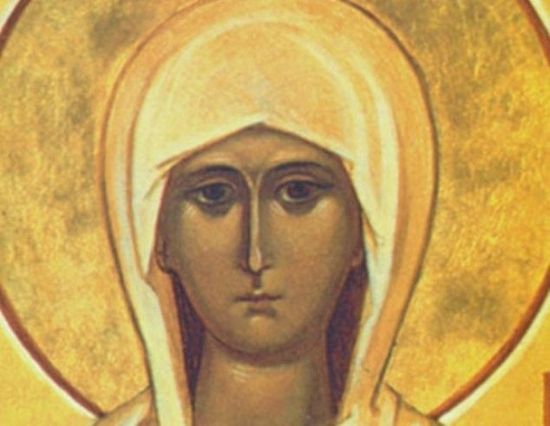
Through His sufferings Christ the Savior redeemed mankind, and opened the gate to the Kingdom of Heaven. During His service he continually preached to all that they follow Him. Those who heard God’s words received them in differing ways, but there were those among them who brought forth fruit in abundance (cf. Mt. 13:8). One of these was the holy equal-to-the-apostles Mary Magdalene. She received that name from the place where she lived, in the town of Magdala. This town belonged to the tribe of Issachar and was located on the western shore of the Sea of Tiberius in Galilee, not far from Capernaum. The naming of a woman for her place of residence shows that she was well-off, because other women’s names were taken, for example, from their family relations: Mary the mother of Jacob, Maria the mother of Cleopas. Luke the Evangelist says that Christ preached the Kingdom of Heaven, and then after Him followed certain women, which had been healed of evil spirits and infirmities, Mary called Magdalene, out of whom went seven devils… and many others, which ministered unto him of their substance (Lk. 8:1–3).
We find the most about Mary Magdalene in the Gospel in passages where the sufferings of Christ the Savior are described, when she showed her dedication and faithfulness to her divine Teacher: Now there stood by the cross of Jesus his mother, and his mother’s sister, Mary the wife of Cleophas, and Mary Magdalene (Jn. 19:25). After the death of the divine Sufferer on the Cross, the centurion on watch believed in the divinity of Christ the Savior. The Evangelist Matthew adds, And many women were there beholding afar off, which followed Jesus from Galilee, ministering unto him: Among which was Mary Magdalene, and Mary the mother of James and Joses, and the mother of Zebedees children (Mt. 27:55–56). Then righteous Joseph of Arimathea asked for the body of the divine Sufferer and buried Him in his own new tomb (Mt. 27–60). As the Evangelist Matthew notes, And there was Mary Magdalene, and the other Mary, sitting over against the sepulcher (Mt. 27:61). The Evangelist Mark says, Mary Magdalene and Mary the mother of Joses beheld where he was laid (Mk. 15:47). Then, when the sabbath was past, Mary Magdalene, and Mary the mother of James, and Salome, had bought sweet spices, that they might come and anoint him (Mk. 16:1). Their worries about the sealed tomb were put to rest all by themselves, when they looked, they saw that the stone was rolled away (Mk. 16:4) and they saw in the tomb a bright angel, who told them the news about the Risen Lord Christ. Then after His resurrection, He appeared first to Mary Magdalene, out of whom he had cast seven devils. And she went and told them that had been with him, as they mourned and wept (Mk. 16:9–10). The Evangelist John the Theologian speaks a little differently and in more detail about the events of those sorrowful days, which would soon become joyful. Mary Magdalene came early, when it was yet dark, unto the sepulchre, and seeth the stone taken away from the sepulcher (Jn. 20:1). She hastened to tell the apostles Peter and John about it, and they in turn hastened to the tomb where they saw the linen clothes lying (Jn. 20:5). Then they returned, but Mary stood without at the sepulchre weeping: and as she wept, she stooped down, and looked into the sepulchre, And seeth two angels in white sitting, the one at the head, and the other at the feet, where the body of Jesus had lain. And they say unto her, Woman, why weepest thou? She saith unto them, Because they have taken away my Lord, and I know not where they have laid him. And when she had thus said, she turned herself back, and saw Jesus standing, and knew not that it was Jesus. Jesus saith unto her, Woman, why weepest thou? whom seekest thou? She, supposing him to be the gardener, saith unto him, Sir, if thou have borne him hence, tell me where thou hast laid him, and I will take him away. Jesus saith unto her, Mary. She turned herself, and saith unto him, Rabboni; which is to say, Master. Jesus saith unto her, Touch me not; for I am not yet ascended to my Father: but go to my brethren, and say unto them, I ascend unto my Father, and your Father; and to my God, and your God. Mary Magdalene came and told the disciples that she had seen the Lord, and that he had spoken these things unto her (Jn. 20:11–18). In the service of the Sunday of the Holy Myrrhbearing Women [the second Sunday after Pascha] we read: “Having come to the tomb seeking the Lord, Mary Magdalene and the other Mary, saw the angel like lightning sitting on the stone, who said to them, ‘Why seek ye the Living among the dead? He has risen as he said. You will find Him in Galilee.”[1]
After the Ascension of the Lord, Mary Magdalene undoubtedly was among certain women (Acts 1:14), who abided in one spirit in prayer with the holy apostles and the Mother of God in the upper room, awaiting the descent of the Holy Spirit. A later traveller describes this place in the holy city of Jerusalem. In the church of Sts. Constantine and Helen, “we were brought … where Christ sat on the stone when He appeared to Maria Magdalene… And the stone, which was the chair, was round, of red rock.”[2] In the church of the Resurrection of Christ “is the stone upon which Christ sat and appeared to Maria Magdalene.”[3]
Church tradition has preserved testimony to her exploits in the capital of the empire. “In Rome, having appeared to the Emperor Tiberius, St. Mary Magdalene brought him a red egg with the words, ‘Christ is Risen!’ Then she told the emperor about the Savior’s sufferings on the Cross. In those days, the presentation of an egg was a sign of joy. From the time of St. Mary Magdalene the trading of eggs on the day of the Resurrection of the Lord amongst Christians became a custom.”[4] This is mentioned in the akathist to the holy Myrrhbearer. In the eleventh ikos we read: “Having reached ancient Rome, courageously didst thou appear before Tiberius Caesar, and with the image of a red egg and wise words thou didst expound to him the life-bearing power of Christ, rebuked deceitful Pilate and the godless high priest, that they will be justly repaid for their lawless deeds… Rejoice, thou who didst not fear Caesar’s wrath; rejoice, thou who didst show him the evil and cunning of Christ’s enemies.”[5] The Church historian Eusebius Pamphilus says that the Roman Emperor Tiberius (14–37) knew from Pilate of the events in Palestine, of the talk about the resurrection of Christ the Savior, “and did not find anything preposterous in Christ’s teachings.”[6] Moreover it is supposed that thanks to Mary Magdalene’s preaching the Roman ruler proposed to the senate that they “include Christ in the pantheon of Roman gods.”[7] The holy Myrrhbearer knew the apostle Paul, whom the Lord had called to preach the Gospel only after His glorious Resurrection, and apparently helped him in his missionary service. Therefore the apostle Paul at the end of his epistle to the Romans writes, Greet Mary, who bestowed much labour on us (Rom. 16:6).
Later Mary Magdalene came to Ephesus, where St. John the Theologian who, as opposed to the other Evangelists, wrote the fourth Gospel significantly later; in it is spoken in detail about the resurrection of Christ the Savior and His appearance to Mary Magdalene. Mary Magdalene reposed in the Lord in Ephesus. St. Dimitry of Rostov (†1709; commemorated October 28), says that she “was laid to rest at the entrance to the cave in which the seven youths of Ephesus would later fall asleep.”[8] In examining the Western version of St. Mary Magdalene’s relics in Provence, Archbishop Sergius (Spassky) notes that “according to the Life of St. Willibald (comm. July 7), bishop of Eichstadt, who travelled to the East in the eighth century, her grave was shown in 745 in Ephesus.”[9] Later her holy relics were translated to Constantinople during the reign of Emperor Leo VI the Philosopher (886–912).[10] Meanwhile Igumen Daniel, who travelled from Kievan Rus’ to the Holy Land at the beginning of the eleventh century, during the heat of the crusades, visited also Ephesus. He wrote, “And here, near that cave where the seven sleeping youths of Ephesus lie, are … also the grave of Magdalene Mary and her head.”[11] And an anonymous Russian traveller who visited Constantinople in the late thirteenth century–early fourth century, that is, after the fall of the Latin empire, describes the holy site in the capital city monastery of Righteous Lazarus: “St. Lazarus the friend of God is sealed in the right column, and his sister Martha lies at his left hand; here … in the left column Mary Magdalene is enclosed.”[12] Later travellers who visited this monastery say nothing about the relics of St. Mary Magdalene.[13]
<…>
The fate of the holy Myrrhbearer’s relics is interesting. Apparently, “during the crusades they were taken to Rome and placed under the altar of the Lateran Cathedral. A part of the relics of St. Mary Magdalene are in France, near Marseille. Particles of her holy relics are preserved in the monasteries of Mt. Athos and Jerusalem.”[14] Many relics of ancient saints, as a consequence of the shameful Fourth Crusade—when in 1204 Constantinople was seized and plundered—ended up in the West. Behind this is the peculiar piety of the Western crusaders. It is worth noting that before and after there were also cases when due to various circumstances the relics of various saints ended up in the West; for example, those of St. Nicholas. An unknown traveller from Suzdal, who went with Metropolitan Isidore in 1438 from Moscow to Italy to the Uniate Council, says of the holy shrines of Venice: “There St. Marko himself lies; and there are many relics of saints, taken from Tsargrad [Constantinople].”[15] Now, centuries later, we can see a special providence in this, because the saints’ relics would have perished from the Turks at the fall of Byzantium.:[16] But during following years the Western Church itself experienced a schism—Protestantism arose, which rejects the veneration of holy relics and icons. Incidentally, the veneration of specific saints in different regions has been preserved and bears a particularly solemn character; for example, in the southern Italian city of Bari they solemnly honor St. Nicholas on May 9: Wearing costumes from the ninth century they carry an ancient sculpture of him through the town, and so forth. In “The Travels of Avraamy of Suzdal to the eighth council with Metropolitan Isidore”, a mystery play is described that was enacted in the Ascension Church of Florence on the very feast of the Ascension. The Mother of God and St. Mary Magdalene were the only female persons named in the play.
Bishop Sergius (Spassky) notes the opinion in Western patristic historiography that equates Mary Magdalene with the sinful woman who washed the feet of Jesus Christ in the house of Simon the Pharisee (Lk. 7:38), as well as the identification of Mary Magdalene with Mary the sister of righteous Lazarus. The Eastern fathers differentiate between them.[17] This is quite an important differentiation in the veneration of the holy Myrrhbearers, because behind it is a different understanding of her life’s path and podvig. Western tradition considers that equal-to-the-apostles Mary Magdalene, after her preaching in Rome, labored in the south of France and Provence, and along with her righteous Martha, Lazarus, and St. Maximinus preached the Gospel. Therefore St. Mary Magdalene is honored as the enlightener of Marseille, who converted its inhabitants to Christianity. The cave, which is preserved in the area of La Sainte Baume, where the holy Myrrhbearer spent time in solitude, later became a place of pious pilgrimage and worship.[18]
In the church of the holy equal-to-the-apostles Mary Magdalene in Saint Maximinus, in the center of the northern part of the basilica there is an entrance to the crypt where the relics of Christ’s disciple were uncovered in 1279.[19] It was discovered that from out of the righteous woman’s mouth a plant was sprouting. Theological thought explained this as a testimony to her special mission: She was an “Apostle to the Apostles”, because it was she who announced the glad tidings of the Resurrection of Christ the Savior to the Apostles.[20] The initiator of the uncovering of the holy relics of Christ’s disciple was Prince Charles of Anjou († 1309), the heir to the duke of Provence. From that time on, Mary Magdalene became the protectress of the Anjou dynasty and of Provence, and her veneration took on a particular, imperial character.[21] A basilica was built over her relics. Here the holy Myrrhbearer is especially honored, and on July 22 according to the Gregorian calendar there are solemnities in the city.
It is important to note the opinion of one Western researcher who “came to the conclusion that the cult of Mary Magdalene arose in Provence no earlier than the mid-eleventh century,”[22] and services to her began in the West “only in the eleventh or twelfth centuries.”[23] They began to write Lives of the holy equal-to-the-apostles Mary Magdalene afterwards: the heremetic edition, the apostolic edition, and then both editions were combined into one. Later her Life was entered into Western hagiographic and homiletic compilations. The co-ascetics and continuers of the labors of St. John Cassian the Roman (†435; comm. February 29) aided in the spread of St. Mary Magdalene’s veneration in Europe.[24]
Because in the West the myrrhbearer was equated with the sinful woman who washed the feet of the Savior with her tears (Lk. 7:38), and the seven devils that tormented her were considered to be “retribution for her sins”,[25] the sermons of the Western clergy glorified St. Mary Magdalene as an example of true repentance.[26] The Eastern tradition, however, considers that these were two different women and that the works of God (Jn. 9:3) were made manifest on her. “Mary Magdalene was possessed by demons not due to her sins or the sins of her parents, but rather it was allowed by God’s Providence in order that the Lord Jesus Christ might show the works of God’s glory, and manifest the great miracle of the healing of Mary Magdalene, the enlightenment of her mind, drawing her to faith in Christ the Savior and to eternal salvation.”[27] Her veneration in the West was multi-faceted. Mary Magdalene’s care for Christ inspired the faithful to good deeds in her name.” Therefore in the Middle Ages guesthouses for travellers appeared that were “under the patronage of St. Mary Magdalene,[28] as well as hospitals and leper colonies. Monasteries were founded in her name, and in fact “monasteries named for St. Mary Magdalene were only outnumbered by those named after the Virgin Mary, which testifies to the great veneration for this saint.”[29] She is also the patron saint of craftsmen of various specializations.[30]
<...>
During life of her Divine Teacher she stood out for her faithfulness and dedication to Him. The later translation of her relics enabled the spread of her veneration in the world. Now, prayers are raised up to her in various countries and Churches. Her name and labors witness to the resurrection Christ the Savior. <...> One preacher said of her: “What a magnificent image of grateful love for the Lord is the holy equal-to-the-apostles Mary Magdalene! And thou, O Christian soul, should like her be penetrated with the same strong and unchanging feeling for the Lord Jesus. By His redeeming service you also are freed in the Sacrament of Baptism, like Magdalene, from the power of the evil, cunning spirits that have nested in you and have had access to people since the time of our forefather’s sin.”[31]
https://orthochristian.com/122857.html |
|
|
|
|
The Grotto of Seven Sleepers in Ephesus
Via Sacra led around the eastern slopes of the Pion Hill (Panayır Dağ) which was a sacred location in the Christian tradition as many saints had supposedly been buried on its slopes or nearby. Taking into consideration even more obscure traditions, the list of these saints is impressive. It includes Mary Magdalene, Saint Hermione, Saint Timothy, Philip the Evangelist, Paul of Thebes, Aristobulos, Adauctus and his daughter Callisthena. However, there is no archaeological evidence to support even one sacred burial from the list. Luckily, the exact location of one holy site recorded in the pious legend from Late Antiquity period has been found: the Grotto of Seven Sleepers, on the eastern slope of the Pion Hill.
|
|
|
 Primer
Primer
 Anterior
2 a 10 de 25
Siguiente
Anterior
2 a 10 de 25
Siguiente Último
Último
|
|
| |
|
|
©2025 - Gabitos - Todos los derechos reservados | |
|
|





 A pilgrim places her prayer petition on the “wishing wall” at the House of the Virgin Mary in Turkey(Photo: GrooveZ)Copyright (c) 2018 GrooveZ/Shutterstock. No use without permission.
A pilgrim places her prayer petition on the “wishing wall” at the House of the Virgin Mary in Turkey(Photo: GrooveZ)Copyright (c) 2018 GrooveZ/Shutterstock. No use without permission.

